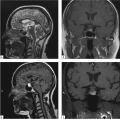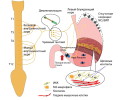Editorial notice
The article presents data about short stature due to intrauterine development delay. This type of short stature — separate nosology, unites children born small for gestation age. The majority of them in the first years of life have accelerated growth rates, allowing the child to normalize their weight-growth indicators and catch up in the development of peers. In the absence of an accelerated growth rates, children have a high risk of lagging behind in physical development throughout childhood, achieving low final growth and becoming short adults. In addition, the fact of birth with small body sizes is associated with a number of hormonal and metabolic features, a risk of metabolic syndrome in adult years.
It is assumed that the absence of postnatal growth acceleration is due to various damages to the GH-IGF1 axis (partial GH deficiency, partial resistance to GH, partial resistance to IGF1). Growth hormone therapy, initiated early in life, is able to normalize growth rates in childhood and ultimately significantly improve or normalize the final growth of short stature children born small for gestational age.
Clinical endocrinology
A severe acute respiratory syndrome coronavirus 2 (SARS-CoV-2) has rapidly spread around the world since was first scientifically described in December 2019. At present approximately 400 million people have suffered from the disease, almost 6 million people have died.
SARS-CoV-2 uses the angiotensin-converting enzyme 2 (ACE2) and the serine protease TMPRSS2 for S protein priming. ACE2 and TMPRSS2 are expressed in several endocrine glands, including the pituitary, pancreas, thyroid, ovaries, and testes. Thus, the endocrine glands may be a direct target for SARS-CoV-2. The main risk factors for severity of the COVID-19 are obesity, arterial hypertension, diabetes mellitus (DM), vertebral fractures, which potentially predisposes patients to a severe course of COVID-19.
In this review, we present current data on the course of COVID-19 in patients with hypothalamic-pituitary diseases, and also discuss treatment for endocrinopathies during to COVID-19.
Hypocalciuric hypercalcemia syndrome (familial hypocalciuric hypercalcemia, FHH) is an inherited condition based on dysfunction of the calcium receptor or its associated partner proteins. Recent evidence suggests that the prevalence of this condition may be comparable to that of primary hyperparathyroidism. Clinical manifestations of FHH are usually absent; however the classic symptoms of hypercalcemia may be present in some cases. Timely differential diagnosis of FHH avoids unnecessary and expensive instrumental examination, as well as ineffective treatment. The clinical cases presented in this publication demonstrate the unjustified difficulties in this issue and the necessity to raise the awareness of physicians about the familial hypocalciuric hypercalcemia.
Hypopituitarism is a state of complete or partial deficiency of pituitary hormones, including adrenal insufficiency, hypothyroidism, hypogonadism, growth hormone deficiency, and, rarely, diabetes insipidus.
The article describes a clinical case of hypopituitarism due to a pituitary tumor in a postmenopausal woman. Difficulties in diagnosing hypopituitarism were due to a history of primary hypothyroidism. The first identified component of panhypopituitarism in the patient, (central hypothyroidism) had previously been seen as laboratory indications of medication-induced hyperthyroidism.
The non-specific nature of the clinical symptoms, as well as a relatively rare combination of endocrine diseases, led to a long examination period and delayed diagnosis of the pituitary tumor.
Whether the development of hypopituitarism in a patient with a nonfunctional pituitary tumor is an indication for transsphenoidal pituitary surgery remains a controversial issue. The decision for surgery is made taking into account the characteristics of the course of the disease in a particular patient. In this clinical case, a conservative tactic was chosen with hormone replacement therapy for glucocorticoid and thyroid deficiency.
Diagnosis and differential diagnosis of patients with diabetes insipidus is often a difficult task for the endocrinologist. This case report focuses on a patient with a long history of central idiopathic diabetes insipidus who had a substantial decrease in desmopressin requirements during the last year of follow-up. Conducting tests with osmotic stimulation (test with water deprivation, infusion test with hypertonic solution) made it possible to answer the question of the persistence of the disease, as well as to determine a further management plan, taking into account the physiological characteristics of our patient.
Metformin is a first-line antidiabetic drug for the treatment of type 2 diabetes mellitus (DM2); its molecular target is AMP-activated protein kinase (AMPK), which is involved in many metabolic processes. Metformin not only reduces blood glucose levels and improves insulin sensitivity, but also inhibits lipolysis and reduces cardiovascular risk in patients with DM2. In recent years, it has been proven that metformin slows down the aging process, stimulates hair growth, eliminates cognitive impairment, and also has an antitumor effect. Most basic studies have shown that metformin inhibits the growth of tumor cells and promotes cellular apoptosis, while clinical studies show contradictory results. This discrepancy can be explained by the difference in the concentration of metformin between basic and clinical studies. The maximum daily dose of metformin for patients with DM2 is 2500 mg / day, and the dose used in basic research was much higher. Metformin directly activates the AMPK signaling pathway, inhibits the production of reactive oxygen species, induces the activation of mTORC1, inhibits cyclin D1, which leads to a reduction in the risk of the occurrence and development of malignant neoplasms. In addition, metformin indirectly inhibits tumor growth, proliferation, invasion and metastasis by reducing the concentration of glucose in the blood, insulin resistance, as well as by reducing inflammation and affecting the tumor microenvironment. Glycolysis plays an important role in the energy metabolism of tumors, and metformin is able to have an inhibitory effect on it. Currently, studies of the mechanism of antitumor effects of metformin are becoming more extensive and in-depth, but there are still some contradictions.
Bones & Adipose tissues diseases
Tumor induced osteomalacia is a rare acquired disease. The cause is a mesenchymal tumor secreting fibroblast growth factor 23 (FGF23). An excessive amount of FGF 23 disrupts the metabolism of phosphorus and vitamin D, which leads to severe paraneoplastic syndrome, manifested in the form of multiple fractures, severe pain in the bones and generalized myopathy. With oncogenic osteomalacia, a complete cure is possible with radical resection of the tumor. Unfortunately, localization, small size of formations and rare frequency of occurrence lead to the fact that the disease remains unrecognized for a long time and leads to severe, disabling consequences. A step-by-step approach to diagnosis improves treatment outcomes. First, a thorough anamnesis is collected, then functional visualization is performed and the diagnosis is confirmed by anatomical visualization of the tumor. After that, the method of choice is a surgical treatment. If resection is not possible, then conservative therapy with active metabolites of vitamin D and phosphorus salts is indicated. New therapeutic approaches, such as the antibody to FGF23 or the pan-inhibitor of receptors to FGF, are actively developing. This article provides an overview of modern approaches to the diagnosis and treatment of this disease.
Carbohidrates metabolism disturbancies
Diabetes mellitus is a chronic disease with a growing prevalence worldwide, however, the prevalence of its complications, including gastroenteropathy, is also increasing. The pathophysiology of diabetic gastroenteropathy (DH) combines hyperglycemia, vagus nerve dysfunction, decreased expression of nitric oxide synthase in the myenteric plexus, changes in the interstitial Cajal cell network, as well as oxidative stress. Clinical signs of DH are gastroesophageal reflux, gastroparesis, constipation, abdominal pain and diarrhea. Among the diagnostic methods are manometry with pH measurement (assessment of esophageal motility), gastric emptying scintigraphy, respiratory test (to assess gastroparesis), aspiration and cultivation of the contents of the jejunum (to diagnose bacterial overgrowth syndrome). To date, there is no definitive treatment for DH — an interdisciplinary approach is aimed at slowing the progression of the disease, relieving symptoms and restoring gastrointestinal function. Patients are recommended a diet low in simple sugars and high in fiber; optimization of glycemic control with a target glycemia of less than 180 mg/dl. As for drug therapy, the use of prokinetics and antiemetics is justified, and in case of excessive bacterial growth syndrome, antibacterial therapy (rifaximin) is carried out. Modern approaches to the treatment of DH are also accumulating, including the use of botulinum toxin, pyloroplasty and electrical stimulation of the stomach in individual patients. Despite the constant development of new treatments, they are not yet able to completely cure DH in the near future, which makes it necessary to conduct further research in this area.
Pediatric Endocrinology
Donohue syndrome (DS), also called Leprechaunism, is the most severe form of insulin resistance associated with biallelic mutations in INSR gene (OMIM: 147670). The approximate incidence of this syndrome is 1 per 1000000 births. Patients are present with typical clinical features such as intrauterine growth retardation, facial dysmorphism, severe metabolic disturbances, hepatomegaly and hypertrophic cardiomyopathy. Most DS patients die within the first two years of life due to respiratory infections, severe hypoglycemia or progressive cardiomyopathy. Treatment options are limited and no specific therapy exist for DS. Given the similarities between insulin and insulin-like growth factor 1 (IGF-1) receptors, recombinant human IGF-1 (rhIGF-1) has been used to treat severe insulin resistance including DS.
We report the case of a male patient with genetically confirmed Donohue syndrome, successfully treated with continuous subcutaneous IGF1 infusion via insulin pump. We observed improvement of glycemic control, liver function and cardiac hypertrophy regression following 15-month IGF1 therapy.
There is a global trend towards an increase in the prevalence of diabetes insipidus. Symptoms of nephrogenic diabetes insipidus with X-linked inheritance appear in men, in women with heterozygous mutations, are characterized by an isolated symptom complex of polyuria, polydipsia, hypostenuria. In children, more often than in adults, with fluid restriction, a clinic of water-deficient dehydration develops with hypernatremia, hyperthermia, and plasma hyperosmolality. This manuscript presents a case of Nephrogenic diabetes insipidus, X-linked familial form in male patients.At the same time, in the family along the female line, the mother and grandmother also had an increased need for water, the use of minirin was ineffective. In the older brother and younger brother, clinical manifestations of diabetes insipidus in the form of severe thirst and polyuria were noted from infancy, after the examination, the diagnosis was made — diabetes insipidus and desmopressin was prescribed.Due to the lack of effect from the use of desmopressin, the analysis of exons and adjacent sections of the introns of the AQP2 and AVPR2 genes was carried out by PCR and subsequent direct sequencing. No mutations were found in the AQP2 gene. The hemizygous substitution S315I was found in the AVPR2 gene. The familial form X was confirmed — linked nephrogenic diabetes insipidus. A hypothiazide was recommended, against the background of constant intake of which only a slight positive trend is observed.
Kabuki syndrome is a rare hereditary disease characterized by distinctive facial features, skeletal abnormalities, mental retardation, developmental delay, and anomalies in multiple organ systems development.
Congenital hyperinsulinism is a rare manifestation of his Kabuki syndrome. However, early diagnosis is crucial to prevent neurological complications of hypoglycemia.
There are 2 types of Kabuki Syndrome depending on severity of symptoms. Kabuki syndrome Type 1 is associated with heterozygous mutations in gene KMT2D. Kabuki syndrome Type 2 is inherited in an X-linked manner. It’s associated with heterozygous mutations in gene KDM6A and characterized by more severe course of the disease.
This paper presents 2 cases of children with congenital hyperinsulinism as the feature of Kabuki syndrome Type 1 and Type 2.
Reproductive Endocrinology
Alzheimer’s disease (AD) is a neurodegenerative disease that causes dementia in half of the cases. Asthma is usually found in people over 65 years of age. The etiopathogenesis of the disease is multifactorial and includes genetic factors, nutritional disorders, mitochondrial dysfunction, oxidative stress, and aging. Sex hormones have an important influence on the development of AD, as evidenced by a higher incidence in women than in men. Considering the significant influence of T on the maintenance of normal brain function, the present study is aimed at evaluating the impact of androgen deprivation therapy (ADT), as well as testosterone therapy, on the risk of AD development and progression. Although there is some clinical inconsistency between studies, androgens have a significant effect on brain function and are beneficial for AD patients. Low levels of circulating androgens should be considered as a significant risk factor for the development of AD and memory loss. With a reduced level of T in the plasma of men, its administration improves cognitive performance and memory, treatment should be started at an early stage of the disease. In men and women with AD, androgens improve mental state and slow the progression of the disease, providing a protective effect. In the future, it is necessary to conduct studies on a large population, taking into account personality factors and a more specific approach to assessing cognitive functions and the causal relationship of T administration in AD.

This work is licensed under a Creative Commons Attribution-NonCommercial-NoDerivatives 4.0 International License (CC BY-NC-ND 4.0).
ISSN 2308-1430 (Online)
















































.jpg)


